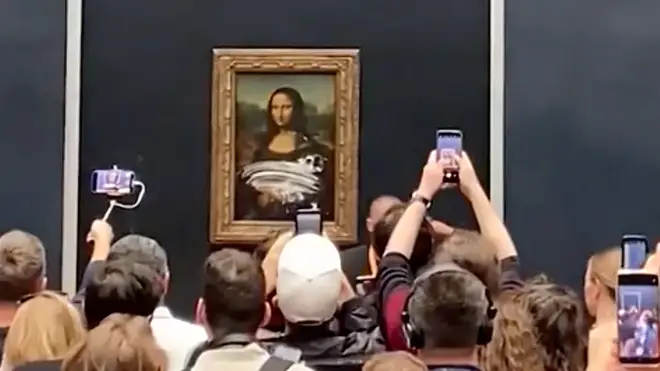Mona Lisa smeared with cake by Louvre ‘protester’ in confusing act of cultural vandalism
30 May 2022, 17:15 | Updated: 30 May 2022, 17:41

A 36-year-old man was arrested after smearing cake over the display case of Leonardo da Vinci’s masterpiece.
Listen to this article
A standard Sunday afternoon in May at the Louvre museum in Paris, France was disrupted when a visitor hurled cake at the Leonardo da Vinci’s 16th-century masterpiece, the Mona Lisa.
The visitor was a 36-year-old man, disguised as an old woman in a wheelchair, who leapt out of the mobility aid when he reached the front of the viewing platform.
He lunged at the display case, attempting to break the bulletproof glass, and then proceeded to cover the glass in cream.
The stunt was reportedly a climate protest, as when the man was dragged away by security he yelled, “Think of the earth, people are destroying the earth.”
The protester has since been arrested and placed in a psychiatric unit, and the Paris prosecutor’s office announced that an inquiry into the “attempt to vandalise a cultural work” had been opened.
Read more: Experts have matched Leonardo da Vinci’s ‘Mona Lisa’ to this enchanting piece of music

Man throws cake on the Mona Lisa at the Louvre in Paris
This isn’t the first time the Mona Lisa has been vandalised at its Paris home. In 1956, a Bolivian man threw a rock at the painting, smashing the glass and dislodging pigment from the subject’s elbow.
Replaced by bulletproof glass, a Russian woman threw a teacup at the painting in 2009, but this only slightly scraped the glass. Police described the offender at the time as “clearly deranged”.
A history of cultural vandalism
Cultural vandalism is the wilful destruction or damage to cultural property, and is not only an issue in the world of art.
Recent examples of this have been seen in the invasion of Ukraine, where cultural pieces such as traditional dress, posters, and venues have been destroyed by the Russian army.
Read more: Russian grenade planted in Ukrainian 10-year-old’s piano: ‘They left a bombshell for a child’

Brass band performs 'Don't Worry, Be Happy' in Odesa amid Russian invasion of Ukraine
In Afghanistan, the Taliban, who recently regained control of the country, have a history of destroying musical instruments, and burning films, VCRs, musical recordings, books, and artwork. They have also jailed and killed musicians, filmmakers and artists.
While the new Taliban regime in the country have yet to completely outlaw music, live music in Afghanistan has been banned.
Last year a folk singer was brutally executed by the Taliban, and many musicians have since tried to escape the country. Of those who remained, some have been arrested. One punishment for musicians who have been arrested is to hang their instrument’s around their necks in mockery.
Others artists have been forced to watch their musical instruments burned in front of them, while members of the Taliban stand around laughing.
Read more: Afghanistan: Musician weeps as Taliban burns his musical instruments in front of him
Video : Taliban burn musician's musical instrument as local musicians weeps. This incident happened in #ZazaiArub District #Paktia Province #Afghanistan . pic.twitter.com/zzCp0POeKl
— Abdulhaq Omeri (@AbdulhaqOmeri) January 15, 2022
On the other side of the spectrum, when potential funding cuts were announced for arts and creative subjects in higher education in England last year, experts called the move, “a colossal act of cultural vandalism”.
The Musicians’ Union claimed the government was “undermining our phenomenally successful creative economy”.
Musician and comedian, Bill Bailey also echoed this sentiment over the recent proposals to privatise Channel 4, the British free-to-air public service television network.
“It’s madness. It’s an act of cultural vandalism,” Bailey said last month. “Once you start monetising assets like that then people running them make decisions about doing less of one thing and more of another just because it makes money.
“That starts polarising the brief around monetisation and that’s never a great direction to go for artists.”


































